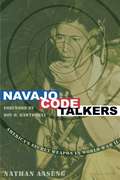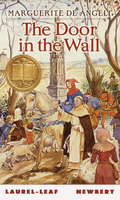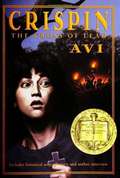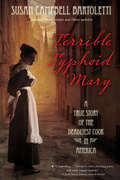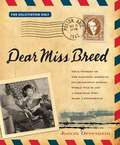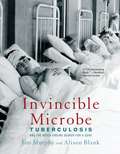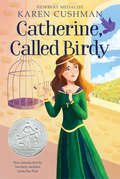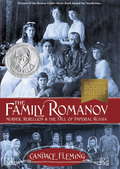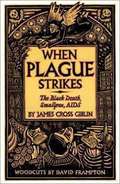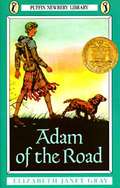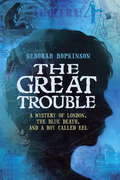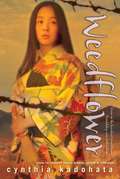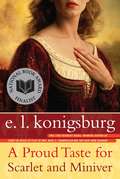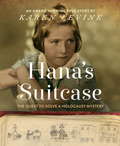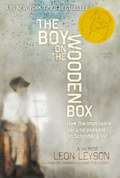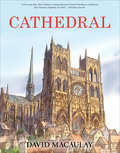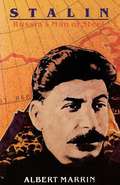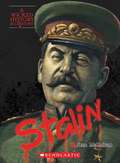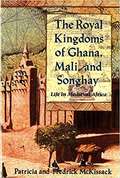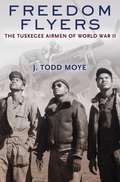Special Collections
District List: BCPS Supplemental Texts - Grade 7
Description: Baltimore City Public Schools Supplemental Text List for students in 7th Grade. #bcps
- Table View
- List View
Navajo Code Talkers
by Nathan AasengOn the Pacific front during World War II, strange messages were picked up by American and Japanese forces on land and at sea. The messages were totally unintelligible to everyone except a small select group within the Marine Corps: the Navajo code talkers-a group of Navajos communicating in a code based on the Navajo language. This code, the first unbreakable one in U.S. history, was a key reason that the Allies were able to win in the Pacific.
Navajo Code Talkers tells the story of the special group, who proved themselves to be among the bravest, most valuable, and most loyal of American soldiers during World War II.
The Door in the Wall
by Marguerite De AngeliAfter losing the use of his legs, the son of a powerful nobleman in 14th-century England sets out to prove his courage and his right to be recognized by the king.
Newbery Medal Winner
Crispin
by Avi"Asta's Son" is all he's ever been called. The lack of a name is appropriate, because he and his mother are but poor peasants in 14th century medieval England. But this thirteen-year-old boy who thought he had little to lose soon finds himself with even less - no home, no family, or possessions. Accused of a crime he did not commit, he may be killed on sight, by anyone. If he wishes to remain alive, he must flee his tiny village. All the boy takes with him is a newly revealed name - Crispin - and his mother's cross of lead.
A Newbery Award Winner.
Terrible Typhoid Mary
by Susan Campbell BartolettiWhat happens when a person's reputation has been forever damaged? With archival photographs and text among other primary sources, this riveting biography of Mary Mallon by the Sibert medalist and Newbery Honor winner Susan Bartoletti looks beyond the tabloid scandal of Mary's controversial life. How she was treated by medical and legal officials reveals a lesser-known story of human and constitutional rights, entangled with the science of pathology and enduring questions about who Mary Mallon really was. How did her name become synonymous with deadly disease? And who is really responsible for the lasting legacy of Typhoid Mary? This thorough exploration includes an author's note, timeline, annotated source notes, and bibliography.
Dear Miss Breed
by Joanne F. Oppenheim and Elizabeth Kikuchi Yamada and Snowden BeckerA chronicle of the incredible correspondence between California librarian Clara Breed and young Japanese American internees during World War II.
In the early 1940's, Clara Breed was the children's librarian at the San Diego Public Library. But she was also friend to dozens of Japanese American children and teens when war broke out in December of 1941.
The story of what happened to these American citizens is movingly told through letters that her young friends wrote to Miss Breed during their internment.
This remarkable librarian and humanitarian served as a lifeline to these imprisoned young people, and was brave enough to speak out against a shameful chapter in American history.
Invincible Microbe
by Jim Murphy and Alison BlankThis is the compelling, suspenseful, down-to-earth story of a killer that has been stalking and doing away with people for thousands of years: Tuberculosis. For centuries TB in many forms was treated with everything from poultices and potions to the king's touch. The microorganism that causes the disease was eventually identified, more effective treatments were developed, and the cure for TB was thought to be within reach. But the TB germ simply will not die; drug-resistant varieties continue to plague and panic the human race. The "biography" of this deadly germ, an account of the diagnosis, treatment, and "cure" of the disease over time, and the social history of an illness that could strike anywhere but was most prevalent among the poor are woven together in an engrossing narrative supported by 70-plus archival prints and photographs. Includes bibliography, source notes, and index.
Catherine, Called Birdy
by Karen CushmanCatherine, a spirited and inquisitive young woman of good family, narrates in diary form the story of her fourteenth year—the year 1290. A Newbery Honor Book.
The Family Romanov
by Candace Fleming"Marrying the intimate family portrait of Heiligman's Charles and Emma with the politics and intrigue of Sheinkin's Bomb, Fleming has outdone herself with this riveting work of narrative nonfiction that appeals to the imagination as much as the intellect." --The Horn Book, StarredFrom the acclaimed author of Amelia Lost and The Lincolns comes a heartrending narrative nonfiction page-turner--and a perfect resource for meeting Common Core standards. When Russia's last tsar, Nicholas II, inherited the throne in 1894, he was unprepared to do so. With their four daughters (including Anastasia) and only son, a hemophiliac, Nicholas and his reclusive wife, Alexandra, buried their heads in the sand, living a life of opulence as World War I raged outside their door and political unrest grew into the Russian Revolution.Deftly maneuvering between the lives of the Romanovs and the plight of Russia's peasants and urban workers--and their eventual uprising--Fleming offers up a fascinating portrait, complete with inserts featuring period photographs and compelling primary-source material that brings it all to life."An exhilarating narrative history of a doomed and clueless family and empire." --Jim Murphy, author of Newbery Honor Books An American Plague and The Great Fire"For readers who regard history as dull, Fleming's extraordinary book is proof positive that, on the contrary, it is endlessly fascinating, absorbing as any novel, and the stuff of an altogether memorable reading experience." --Booklist, Starred
Winner of the Sibert Honor
When Plague Strikes
by James Cross GiblinThe book explains three deadly epidemic diseases that have struck the human race, along with their history, causes and consequences to mankind
Adam of the Road
by Elizabeth Janet GrayAwarded the John Newbery Medal as "the most distinguished contribution to American literature for children" in the year of its publication.
"A road's a kind of holy thing," said Roger the Minstrel to his son, Adam. "That's why it's a good work to keep a road in repair, like giving alms to the poor or tending the sick. It's open to the sun and wind and rain. It brings all kinds of people and all parts of England together. And it's home to a minstrel, even though he may happen to be sleeping in a castle." And Adam, though only eleven, was to remember his father's words when his beloved dog, Nick, was stolen and Roger had disappeared and he found himself traveling alone along these same great roads, searching the fairs and market towns for his father and his dog.
Here is a story of thirteenth-century England, so absorbing and lively that for all its authenticity it scarcely seems "historical." Although crammed with odd facts and lore about that time when "longen folke to goon on pilgrimages," its scraps of song and hymn and jongleur's tale of the period seem as newminted and fresh as the day they were devised, and Adam is a real boy inside his gay striped surcoat.
The Great Trouble
by Deborah HopkinsonEel has troubles of his own: As an orphan and a "mudlark," he spends his days in the filthy River Thames, searching for bits of things to sell. He's being hunted by Fisheye Bill Tyler, and a nastier man never walked the streets of London. And he's got a secret that costs him four precious shillings a week to keep safe. But even for Eel, things aren't so bad until that fateful August day in 1854--the day the Great Trouble begins. Mr. Griggs, the tailor, is the first to get sick, and soon it's clear that the deadly cholera--the "blue death"--has come to Broad Street. Everyone believes that cholera is spread through poisonous air. But one man, Dr. John Snow, has a different theory. As the epidemic surges, it's up to Eel and his best friend Florrie to gather evidence to prove Snow's theory before the entire neighborhood is wiped out.Part medical mystery, part survival story, and part Dickensian adventure, Deborah Hopkinson's The Great Trouble is a celebration of a fascinating pioneer in public health and a gripping novel about the 1854 London cholera epidemic.
Weedflower
by Cynthia KadohataTwelve-year-old Sumiko feels her life has been made up of two parts: before Pearl Harbor and after it. The good part and the bad part. Raised on a flower farm in California, Sumiko is used to being the only Japanese girl in her class. Even when the other kids tease her, she always has had her flowers and family to go home to. That all changes after the horrific events of Pearl Harbor. Other Americans start to suspect that all Japanese people are spies for the emperor, even if, like Sumiko, they were born in the United States! As suspicions grow, Sumiko and her family find themselves being shipped to an internment camp in one of the hottest deserts in the United States. The vivid color of her previous life is gone forever, and now dust storms regularly choke the sky and seep into every crack of the military barrack that is her new "home." Sumiko soon discovers that the camp is on an Indian reservation and that the Japanese are as unwanted there as they'd been at home. But then she meets a young Mohave boy who might just become her first real friend...if he can ever stop being angry about the fact that the internment camp is on his tribe's land. With searing insight and clarity, Newbery Medal-winning author Cynthia Kadohata explores an important and painful topic through the eyes of a young girl who yearns to belong. Weedflower is the story of the rewards and challenges of a friendship across the racial divide, as well as the based-on-real-life story of how the meeting of Japanese Americans and Native Americans changed the future of both.
A Proud Taste for Scarlet and Miniver
by E.L. KonigsburgEleanor of Acquitaine has been waiting in Heaven for a long time to be reunited with her second husband, Henry II of England. Finally, the day has come when Henry will be judged for admission--and while Eleanor waits, three people close to her during various times of her life join her, helping to distract her and providing a rich portrait of a remarkable woman in history.
Hana's Suitcase
by Karen LevineThis award-winning true Holocaust story, newly updated, connects generations through one woman's quest to find the truth behind a mysterious suitcase. In March 2000, Fumiko Ishioka, the curator of a small Holocaust education center in Tokyo, received an empty suitcase from the museum at Auschwitz. On the outside, in white paint, were the words "Hana Brady, May 16, 1931, Orphan." Fumiko and the children at the center were determined to find out who Hana was and what happened to her all those years ago, leading them to a startling and emotional discovery. The dual narrative intertwines Fumiko's international journey to find the truth about Hana Brady's fate with Hana's own compelling story of her life in a quiet Czech town, which is shattered by the arrival of the Nazis, tearing apart the family she loves. This suspense-filled work of investigative nonfiction draws in young readers and makes them active participants in the search for Hana's identity. Praise for Hana's Suitcase * "Hana wanted to become a teacher, and surely through this little book her dream is being realized." --Archbishop Desmond Tutu, from his new foreword to Hana's Suitcase * "The account . . . is part history, part suspenseful mystery . . . with an incredible climactic revelation." --Booklist
The Boy on the Wooden Box
by Leon LeysonEven in the darkest of times--especially in the darkest of times--there is room for strength and bravery. A remarkable memoir from Leon Leyson, one of the youngest children to survive the Holocaust on Oskar Schindler's list.Leon Leyson (born Leib Lezjon) was only ten years old when the Nazis invaded Poland and his family was forced to relocate to the Krakow ghetto. With incredible luck, perseverance, and grit, Leyson was able to survive the sadism of the Nazis, including that of the demonic Amon Goeth, commandant of Plaszow, the concentration camp outside Krakow. Ultimately, it was the generosity and cunning of one man, a man named Oskar Schindler, who saved Leon Leyson's life, and the lives of his mother, his father, and two of his four siblings, by adding their names to his list of workers in his factory--a list that became world renowned: Schindler's List. This, the only memoir published by a former Schindler's List child, perfectly captures the innocence of a small boy who goes through the unthinkable. Most notable is the lack of rancor, the lack of venom, and the abundance of dignity in Mr. Leyson's telling. The Boy on the Wooden Box is a legacy of hope, a memoir unlike anything you've ever read.
Cathedral
by David MacaulayReaders worldwide recognize Caldecott Medal winner David Macaulay's imaginary Cathedral of Chutreaux. This critically acclaimed book has been translated into a dozen languages and remains a classic of children's literature and a touchstone for budding architects.
Cathedral's numerous awards include a prestigious Caldecott Honor and designation as a New York Times Best Illustrated Book of the Year for Macaulay's intricate pen-and-ink illustrations. Journey back to centuries long ago and visit the fictional people of twelfth-, thirteenth-, and fourteenth-century Europe whose dreams, like Cathedral, stand the test of time.
This title has been selected as a Common Core text exemplar (Grades 6-8, Informational Texts: Science, Mathematics, and Technical Studies).
Oh, Rats! The Story of Rats and People
by Albert MarrinA children's book about rats, their ancestors, how they live with people, how to get rid of them, and rats and disease. Includes a bibliography.
Stalin
by Albert MarrinEnamored as a young man with the revolutionary politics of Lenin, he joined the underground Marxist Party and began his pursuit of power by leading strikes and demonstrations.
Six times he was exiled to Siberia for his illicit activities, escaping many times despite below freezing temperatures and on one occasion an attack by a pack of wolves.
A Wicked History 20th Century
by Sean MccollumIt's hard to imagine any fictional villain half as fiendish as the real-life warlords, tyrants, and pirates in these new Wicked biographies. Bet you can't read just one! He ruled with an iron fist, using his ruthless secret police to exterminate enemies of the state for more than three decades. By the time he died, some 700,000 people-mostly ordinary citizens-had been executed or sent to work camps. Meet Generalissimo Joseph Stalin, the most reviled communist leader of them all.
The Royal Kingdoms of Ghana, Mali and Songhay
by Patricia C. Mckissack and Fredrick L. MckissackFor more than a thousand years, from A.D. 500 to 1700, the medieval kingdoms of Ghana, Mali, and Songhay grew rich on the gold, salt, and slave trade that stretched across Africa. Scraping away hundreds of years of ignorance, prejudice, and mythology, award-winning authors Patricia and Fredrick McKissack reveal the glory of these forgotten empires while inviting us to share in the inspiring process of historical recovery that is taking place today.
Freedom Flyers
by J. Todd MoyeAs the country's first African American military pilots, the Tuskegee Airmen fought in World War II on two fronts: against the Axis powers in the skies over Europe and against Jim Crow racism and segregation at home. Although the pilots flew more than 15,000 sorties and destroyed more than 200 German aircraft, their most far-reaching achievement defies quantification: delivering a powerful blow to racial inequality and discrimination in American life. In this inspiring account of the Tuskegee Airmen, historian J. Todd Moye captures the challenges and triumphs of these brave pilots in their own words, drawing on more than 800 interviews recorded for the National Park Service's Tuskegee Airmen Oral History Project. Denied the right to fully participate in the U. S. war effort alongside whites at the beginning of World War II, African Americans--spurred on by black newspapers and civil rights organizations such as the NAACP--compelled the prestigious Army Air Corps to open its training programs to black pilots, despite the objections of its top generals. Thousands of young men came from every part of the country to Tuskegee, Alabama, in the heart of the segregated South, to enter the program, which expanded in 1943 to train multi-engine bomber pilots in addition to fighter pilots. By the end of the war, Tuskegee Airfield had become a small city populated by black mechanics, parachute packers, doctors, and nurses. Together, they helped prove that racial segregation of the fighting forces was so inefficient as to be counterproductive to the nation's defense. Freedom Flyersbrings to life the legacy of a determined, visionary cadre of African American airmen who proved their capabilities and patriotism beyond question, transformed the armed forces--formerly the nation's most racially polarized institution--and jump-started the modern struggle for racial equality.
